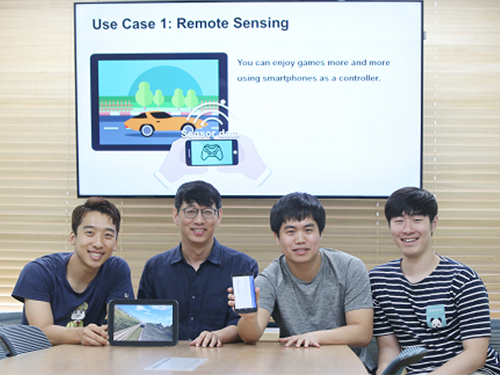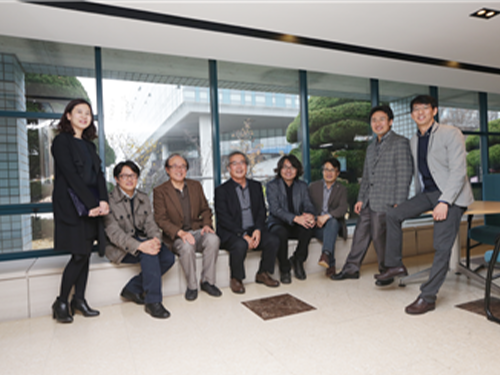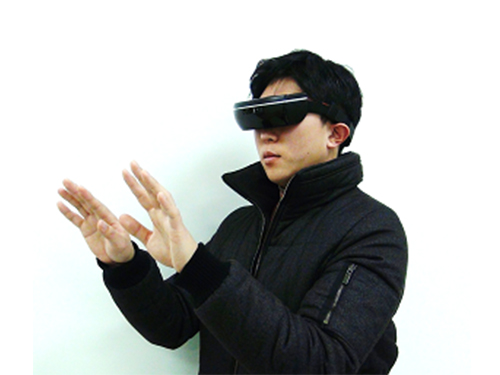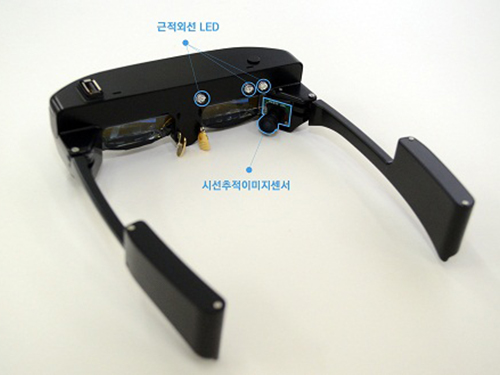User+experience
-
 Multi-Device Mobile Platform for App Functionality Sharing
Case 1. Mr. Kim, an employee, logged on to his SNS account using a tablet PC at the airport while traveling overseas. However, a malicious virus was installed on the tablet PC and some photos posted on his SNS were deleted by someone else.
Case 2. Mr. and Mrs. Brown are busy contacting credit card and game companies, because his son, who likes games, purchased a million dollars worth of game items using his smartphone.
Case 3. Mr. Park, who enjoys games, bought a sensor-based racing game through his tablet PC. However, he could not enjoy the racing game on his tablet because it was not comfortable to tilt the device for game control.
The above cases are some of the various problems that can arise in modern society where diverse smart devices, including smartphones, exist. Recently, new technology has been developed to easily solve these problems. Professor Insik Shin from the School of Computing has developed ‘Mobile Plus,’ which is a mobile platform that can share the functionalities of applications between smart devices.
This is a novel technology that allows applications to easily share their functionalities without needing any modifications. Smartphone users often use Facebook to log in to another SNS account like Instagram, or use a gallery app to post some photos on their SNS. These examples are possible, because the applications share their login and photo management functionalities.
The functionality sharing enables users to utilize smartphones in various and convenient ways and allows app developers to easily create applications. However, current mobile platforms such as Android or iOS only support functionality sharing within a single mobile device. It is burdensome for both developers and users to share functionalities across devices because developers would need to create more complex applications and users would need to install the applications on each device.
To address this problem, Professor Shin’s research team developed platform technology to support functionality sharing between devices. The main concept is using virtualization to give the illusion that the applications running on separate devices are on a single device. They succeeded in this virtualization by extending a RPC (Remote Procedure Call) scheme to multi-device environments.
This virtualization technology enables the existing applications to share their functionalities without needing any modifications, regardless of the type of applications. So users can now use them without additional purchases or updates. Mobile Plus can support hardware functionalities like cameras, microphones, and GPS as well as application functionalities such as logins, payments, and photo sharing. Its greatest advantage is its wide range of possible applications.
Professor Shin said, "Mobile Plus is expected to have great synergy with smart home and smart car technologies. It can provide novel user experiences (UXs) so that users can easily utilize various applications of smart home/vehicle infotainment systems by using a smartphone as their hub."
This research was published at ACM MobiSys, an international conference on mobile computing that was hosted in the United States on June 21.
Figure1. Users can securely log on to SNS accounts by using their personal devices
Figure 2. Parents can control impulse shopping of their children.
Figure 3. Users can enjoy games more and more by using the smartphone as a controller.
2017.08.09 View 10184
Multi-Device Mobile Platform for App Functionality Sharing
Case 1. Mr. Kim, an employee, logged on to his SNS account using a tablet PC at the airport while traveling overseas. However, a malicious virus was installed on the tablet PC and some photos posted on his SNS were deleted by someone else.
Case 2. Mr. and Mrs. Brown are busy contacting credit card and game companies, because his son, who likes games, purchased a million dollars worth of game items using his smartphone.
Case 3. Mr. Park, who enjoys games, bought a sensor-based racing game through his tablet PC. However, he could not enjoy the racing game on his tablet because it was not comfortable to tilt the device for game control.
The above cases are some of the various problems that can arise in modern society where diverse smart devices, including smartphones, exist. Recently, new technology has been developed to easily solve these problems. Professor Insik Shin from the School of Computing has developed ‘Mobile Plus,’ which is a mobile platform that can share the functionalities of applications between smart devices.
This is a novel technology that allows applications to easily share their functionalities without needing any modifications. Smartphone users often use Facebook to log in to another SNS account like Instagram, or use a gallery app to post some photos on their SNS. These examples are possible, because the applications share their login and photo management functionalities.
The functionality sharing enables users to utilize smartphones in various and convenient ways and allows app developers to easily create applications. However, current mobile platforms such as Android or iOS only support functionality sharing within a single mobile device. It is burdensome for both developers and users to share functionalities across devices because developers would need to create more complex applications and users would need to install the applications on each device.
To address this problem, Professor Shin’s research team developed platform technology to support functionality sharing between devices. The main concept is using virtualization to give the illusion that the applications running on separate devices are on a single device. They succeeded in this virtualization by extending a RPC (Remote Procedure Call) scheme to multi-device environments.
This virtualization technology enables the existing applications to share their functionalities without needing any modifications, regardless of the type of applications. So users can now use them without additional purchases or updates. Mobile Plus can support hardware functionalities like cameras, microphones, and GPS as well as application functionalities such as logins, payments, and photo sharing. Its greatest advantage is its wide range of possible applications.
Professor Shin said, "Mobile Plus is expected to have great synergy with smart home and smart car technologies. It can provide novel user experiences (UXs) so that users can easily utilize various applications of smart home/vehicle infotainment systems by using a smartphone as their hub."
This research was published at ACM MobiSys, an international conference on mobile computing that was hosted in the United States on June 21.
Figure1. Users can securely log on to SNS accounts by using their personal devices
Figure 2. Parents can control impulse shopping of their children.
Figure 3. Users can enjoy games more and more by using the smartphone as a controller.
2017.08.09 View 10184 -
 Mobile Software Platform Research Center Recognized by the MSIP
The Mobile Software Platform Research Center (MSPRC) at KAIST received an award from the Minister of Science, ICT and Future Planning of Korea on November 29, 2016, at Coex in Seoul. The award was presented at the Conference of Software R&D Annual Report 2016 hosted by the Ministry of Science, ICT and Future Planning (MISP) and the Institute for Information and Communications Technology Promotion (IITP).
The research center developed user experience (UX)-oriented mobile software platforms that support the invention of next-generation UX service technologies. The center has filed 37 patents and registered 15 technologies. Its researchers received ten Best Paper Awards and published a total of 133 papers in Korean and international journals.
Research teams at MSPRC expect that their software platforms will offer training programs for software engineers and new UX services. They also said that their extensive event processing platforms would reduce energy consumption on mobile devices.
Professor Seungryoul Maeng of the School of Computing, the Director of MSPRC, said, “This is a great honor for us. I am greatly thankful for the teamwork of participating departments--Computer Science, Industrial Design, and Industrial and Systems Engineering. We will continue to introduce our research outcomes and to work towards commercializing these results.”
Members of the Mobile Software Platform Research Center, KAIST
2016.12.07 View 7567
Mobile Software Platform Research Center Recognized by the MSIP
The Mobile Software Platform Research Center (MSPRC) at KAIST received an award from the Minister of Science, ICT and Future Planning of Korea on November 29, 2016, at Coex in Seoul. The award was presented at the Conference of Software R&D Annual Report 2016 hosted by the Ministry of Science, ICT and Future Planning (MISP) and the Institute for Information and Communications Technology Promotion (IITP).
The research center developed user experience (UX)-oriented mobile software platforms that support the invention of next-generation UX service technologies. The center has filed 37 patents and registered 15 technologies. Its researchers received ten Best Paper Awards and published a total of 133 papers in Korean and international journals.
Research teams at MSPRC expect that their software platforms will offer training programs for software engineers and new UX services. They also said that their extensive event processing platforms would reduce energy consumption on mobile devices.
Professor Seungryoul Maeng of the School of Computing, the Director of MSPRC, said, “This is a great honor for us. I am greatly thankful for the teamwork of participating departments--Computer Science, Industrial Design, and Industrial and Systems Engineering. We will continue to introduce our research outcomes and to work towards commercializing these results.”
Members of the Mobile Software Platform Research Center, KAIST
2016.12.07 View 7567 -
 Professor Kun-pyo Lee Appointed Honorary Fellow of the Design Research Society
Founded in the United Kingdom (UK) in 1966, the Design Research Society is an international academic organization that promotes excellence in design and supports the interests of the design research community.
Professor Kun-pyo Lee of the Industrial Design Department at KAIST received his honorary fellowship from the Society at its 50th international conference held from June 27, 2016 to July 3, 2016 in Brighton, UK.
The Society recognized Professor Lee’s academic achievements and his contribution to the advancement of design research nationally and globally. To date, only eight researchers have received honorary fellowships from the Society, and he is the first Asian to become an honorary fellow.
Professor Lee has worked at KAIST for more than 30 years as a professor in industrial engineering and served on various important positions such as the president of the Korean Society of Design Science, the president of the International Association of Societies of Design Research, an executive vice president of the Corporate Design Center at LG Electronics, and an advisory board member for Human-centered Design Network in Japan and UXnet in the United States.
By introducing the concept of user experience (UX) in Korea for the first time, he developed this field while focusing on user-centered designs to optimize interactive digital products as well as interaction design to create mental and physical interfaces between people and interactive digital products, services, and systems.
Professor Lee said, “I am pleased to become an honorary fellow of the Design Research Society. For quiet some time, industrial design remained in the domain of practical studies, lacking the kind of support needed to grow as an independent academic and research discipline, but this has changed rapidly in recent years. I will continue to remain actively involved in the development of industrial design engineering in Korea and the world.”
2016.07.19 View 8420
Professor Kun-pyo Lee Appointed Honorary Fellow of the Design Research Society
Founded in the United Kingdom (UK) in 1966, the Design Research Society is an international academic organization that promotes excellence in design and supports the interests of the design research community.
Professor Kun-pyo Lee of the Industrial Design Department at KAIST received his honorary fellowship from the Society at its 50th international conference held from June 27, 2016 to July 3, 2016 in Brighton, UK.
The Society recognized Professor Lee’s academic achievements and his contribution to the advancement of design research nationally and globally. To date, only eight researchers have received honorary fellowships from the Society, and he is the first Asian to become an honorary fellow.
Professor Lee has worked at KAIST for more than 30 years as a professor in industrial engineering and served on various important positions such as the president of the Korean Society of Design Science, the president of the International Association of Societies of Design Research, an executive vice president of the Corporate Design Center at LG Electronics, and an advisory board member for Human-centered Design Network in Japan and UXnet in the United States.
By introducing the concept of user experience (UX) in Korea for the first time, he developed this field while focusing on user-centered designs to optimize interactive digital products as well as interaction design to create mental and physical interfaces between people and interactive digital products, services, and systems.
Professor Lee said, “I am pleased to become an honorary fellow of the Design Research Society. For quiet some time, industrial design remained in the domain of practical studies, lacking the kind of support needed to grow as an independent academic and research discipline, but this has changed rapidly in recent years. I will continue to remain actively involved in the development of industrial design engineering in Korea and the world.”
2016.07.19 View 8420 -
 K-Glass 3 Offers Users a Keyboard to Type Text
KAIST researchers upgraded their smart glasses with a low-power multicore processor to employ stereo vision and deep-learning algorithms, making the user interface and experience more intuitive and convenient.
K-Glass, smart glasses reinforced with augmented reality (AR) that were first developed by KAIST in 2014, with the second version released in 2015, is back with an even stronger model. The latest version, which KAIST researchers are calling K-Glass 3, allows users to text a message or type in key words for Internet surfing by offering a virtual keyboard for text and even one for a piano.
Currently, most wearable head-mounted displays (HMDs) suffer from a lack of rich user interfaces, short battery lives, and heavy weight. Some HMDs, such as Google Glass, use a touch panel and voice commands as an interface, but they are considered merely an extension of smartphones and are not optimized for wearable smart glasses. Recently, gaze recognition was proposed for HMDs including K-Glass 2, but gaze cannot be realized as a natural user interface (UI) and experience (UX) due to its limited interactivity and lengthy gaze-calibration time, which can be up to several minutes.
As a solution, Professor Hoi-Jun Yoo and his team from the Electrical Engineering Department recently developed K-Glass 3 with a low-power natural UI and UX processor. This processor is composed of a pre-processing core to implement stereo vision, seven deep-learning cores to accelerate real-time scene recognition within 33 milliseconds, and one rendering engine for the display.
The stereo-vision camera, located on the front of K-Glass 3, works in a manner similar to three dimension (3D) sensing in human vision. The camera’s two lenses, displayed horizontally from one another just like depth perception produced by left and right eyes, take pictures of the same objects or scenes and combine these two different images to extract spatial depth information, which is necessary to reconstruct 3D environments. The camera’s vision algorithm has an energy efficiency of 20 milliwatts on average, allowing it to operate in the Glass more than 24 hours without interruption.
The research team adopted deep-learning-multi core technology dedicated for mobile devices. This technology has greatly improved the Glass’s recognition accuracy with images and speech, while shortening the time needed to process and analyze data. In addition, the Glass’s multi-core processor is advanced enough to become idle when it detects no motion from users. Instead, it executes complex deep-learning algorithms with a minimal power to achieve high performance.
Professor Yoo said, “We have succeeded in fabricating a low-power multi-core processer that consumes only 126 milliwatts of power with a high efficiency rate. It is essential to develop a smaller, lighter, and low-power processor if we want to incorporate the widespread use of smart glasses and wearable devices into everyday life. K-Glass 3’s more intuitive UI and convenient UX permit users to enjoy enhanced AR experiences such as a keyboard or a better, more responsive mouse.”
Along with the research team, UX Factory, a Korean UI and UX developer, participated in the K-Glass 3 project.
These research results entitled “A 126.1mW Real-Time Natural UI/UX Processor with Embedded Deep-Learning Core for Low-Power Smart Glasses” (lead author: Seong-Wook Park, a doctoral student in the Electrical Engineering Department, KAIST) were presented at the 2016 IEEE (Institute of Electrical and Electronics Engineers) International Solid-State Circuits Conference (ISSCC) that took place January 31-February 4, 2016 in San Francisco, California.
YouTube Link: https://youtu.be/If_anx5NerQ
Figure 1: K-Glass 3
K-Glass 3 is equipped with a stereo camera, dual microphones, a WiFi module, and eight batteries to offer higher recognition accuracy and enhanced augmented reality experiences than previous models.
Figure 2: Architecture of the Low-Power Multi-Core Processor
K-Glass 3’s processor is designed to include several cores for pre-processing, deep-learning, and graphic rendering.
Figure 3: Virtual Text and Piano Keyboard
K-Glass 3 can detect hands and recognize their movements to provide users with such augmented reality applications as a virtual text or piano keyboard.
2016.02.26 View 13462
K-Glass 3 Offers Users a Keyboard to Type Text
KAIST researchers upgraded their smart glasses with a low-power multicore processor to employ stereo vision and deep-learning algorithms, making the user interface and experience more intuitive and convenient.
K-Glass, smart glasses reinforced with augmented reality (AR) that were first developed by KAIST in 2014, with the second version released in 2015, is back with an even stronger model. The latest version, which KAIST researchers are calling K-Glass 3, allows users to text a message or type in key words for Internet surfing by offering a virtual keyboard for text and even one for a piano.
Currently, most wearable head-mounted displays (HMDs) suffer from a lack of rich user interfaces, short battery lives, and heavy weight. Some HMDs, such as Google Glass, use a touch panel and voice commands as an interface, but they are considered merely an extension of smartphones and are not optimized for wearable smart glasses. Recently, gaze recognition was proposed for HMDs including K-Glass 2, but gaze cannot be realized as a natural user interface (UI) and experience (UX) due to its limited interactivity and lengthy gaze-calibration time, which can be up to several minutes.
As a solution, Professor Hoi-Jun Yoo and his team from the Electrical Engineering Department recently developed K-Glass 3 with a low-power natural UI and UX processor. This processor is composed of a pre-processing core to implement stereo vision, seven deep-learning cores to accelerate real-time scene recognition within 33 milliseconds, and one rendering engine for the display.
The stereo-vision camera, located on the front of K-Glass 3, works in a manner similar to three dimension (3D) sensing in human vision. The camera’s two lenses, displayed horizontally from one another just like depth perception produced by left and right eyes, take pictures of the same objects or scenes and combine these two different images to extract spatial depth information, which is necessary to reconstruct 3D environments. The camera’s vision algorithm has an energy efficiency of 20 milliwatts on average, allowing it to operate in the Glass more than 24 hours without interruption.
The research team adopted deep-learning-multi core technology dedicated for mobile devices. This technology has greatly improved the Glass’s recognition accuracy with images and speech, while shortening the time needed to process and analyze data. In addition, the Glass’s multi-core processor is advanced enough to become idle when it detects no motion from users. Instead, it executes complex deep-learning algorithms with a minimal power to achieve high performance.
Professor Yoo said, “We have succeeded in fabricating a low-power multi-core processer that consumes only 126 milliwatts of power with a high efficiency rate. It is essential to develop a smaller, lighter, and low-power processor if we want to incorporate the widespread use of smart glasses and wearable devices into everyday life. K-Glass 3’s more intuitive UI and convenient UX permit users to enjoy enhanced AR experiences such as a keyboard or a better, more responsive mouse.”
Along with the research team, UX Factory, a Korean UI and UX developer, participated in the K-Glass 3 project.
These research results entitled “A 126.1mW Real-Time Natural UI/UX Processor with Embedded Deep-Learning Core for Low-Power Smart Glasses” (lead author: Seong-Wook Park, a doctoral student in the Electrical Engineering Department, KAIST) were presented at the 2016 IEEE (Institute of Electrical and Electronics Engineers) International Solid-State Circuits Conference (ISSCC) that took place January 31-February 4, 2016 in San Francisco, California.
YouTube Link: https://youtu.be/If_anx5NerQ
Figure 1: K-Glass 3
K-Glass 3 is equipped with a stereo camera, dual microphones, a WiFi module, and eight batteries to offer higher recognition accuracy and enhanced augmented reality experiences than previous models.
Figure 2: Architecture of the Low-Power Multi-Core Processor
K-Glass 3’s processor is designed to include several cores for pre-processing, deep-learning, and graphic rendering.
Figure 3: Virtual Text and Piano Keyboard
K-Glass 3 can detect hands and recognize their movements to provide users with such augmented reality applications as a virtual text or piano keyboard.
2016.02.26 View 13462 -
 KAIST Introduces New UI for K-Glass 2
A newly developed user interface, the “i-Mouse,” in the K-Glass 2 tracks the user’s gaze and connects the device to the Internet through blinking eyes such as winks. This low-power interface provides smart glasses with an excellent user experience, with a long-lasting battery and augmented reality.
Smart glasses are wearable computers that will likely lead to the growth of the Internet of Things. Currently available smart glasses, however, reveal a set of problems for commercialization, such as short battery life and low energy efficiency. In addition, glasses that use voice commands have raised the issue of privacy concerns.
A research team led by Professor Hoi-Jun Yoo of the Electrical Engineering Department at the Korea Advanced Institute of Science and Technology (KAIST) has recently developed an upgraded model of the K-Glass (http://www.eurekalert.org/pub_releases/2014-02/tkai-kdl021714.php) called “K-Glass 2.”
K-Glass 2 detects users’ eye movements to point the cursor to recognize computer icons or objects in the Internet, and uses winks for commands. The researchers call this interface the “i-Mouse,” which removes the need to use hands or voice to control a mouse or touchpad. Like its predecessor, K-Glass 2 also employs augmented reality, displaying in real time the relevant, complementary information in the form of text, 3D graphics, images, and audio over the target objects selected by users.
The research results were presented, and K-Glass 2’s successful operation was demonstrated on-site to the 2015 Institute of Electrical and Electronics Engineers (IEEE) International Solid-State Circuits Conference (ISSCC) held on February 23-25, 2015 in San Francisco. The title of the paper was “A 2.71nJ/Pixel 3D-Stacked Gaze-Activated Object Recognition System for Low-power Mobile HMD Applications” (http://ieeexplore.ieee.org/Xplore/home.jsp).
The i-Mouse is a new user interface for smart glasses in which the gaze-image sensor (GIS) and object recognition processor (ORP) are stacked vertically to form a small chip. When three infrared LEDs (light-emitting diodes) built into the K-Glass 2 are projected into the user’s eyes, GIS recognizes their focal point and estimates the possible locations of the gaze as the user glances over the display screen. Then the electro-oculography sensor embedded on the nose pads reads the user’s eyelid movements, for example, winks, to click the selection. It is worth noting that the ORP is wired to perform only within the selected region of interest (ROI) by users. This results in a significant saving of battery life. Compared to the previous ORP chips, this chip uses 3.4 times less power, consuming on average 75 milliwatts (mW), thereby helping K-Glass 2 to run for almost 24 hours on a single charge.
Professor Yoo said, “The smart glass industry will surely grow as we see the Internet of Things becomes commonplace in the future. In order to expedite the commercial use of smart glasses, improving the user interface (UI) and the user experience (UX) are just as important as the development of compact-size, low-power wearable platforms with high energy efficiency. We have demonstrated such advancement through our K-Glass 2. Using the i-Mouse, K-Glass 2 can provide complicated augmented reality with low power through eye clicking.”
Professor Yoo and his doctoral student, Injoon Hong, conducted this research under the sponsorship of the Brain-mimicking Artificial Intelligence Many-core Processor project by the Ministry of Science, ICT and Future Planning in the Republic of Korea.
Youtube Link:
https://www.youtube.com/watchv=JaYtYK9E7p0&list=PLXmuftxI6pTW2jdIf69teY7QDXdI3Ougr
Picture 1: K-Glass 2
K-Glass 2 can detect eye movements and click computer icons via users’ winking.
Picture 2: Object Recognition Processor Chip
This picture shows a gaze-activated object-recognition system.
Picture 3: Augmented Reality Integrated into K-Glass 2
Users receive additional visual information overlaid on the objects they select.
2015.03.13 View 16806
KAIST Introduces New UI for K-Glass 2
A newly developed user interface, the “i-Mouse,” in the K-Glass 2 tracks the user’s gaze and connects the device to the Internet through blinking eyes such as winks. This low-power interface provides smart glasses with an excellent user experience, with a long-lasting battery and augmented reality.
Smart glasses are wearable computers that will likely lead to the growth of the Internet of Things. Currently available smart glasses, however, reveal a set of problems for commercialization, such as short battery life and low energy efficiency. In addition, glasses that use voice commands have raised the issue of privacy concerns.
A research team led by Professor Hoi-Jun Yoo of the Electrical Engineering Department at the Korea Advanced Institute of Science and Technology (KAIST) has recently developed an upgraded model of the K-Glass (http://www.eurekalert.org/pub_releases/2014-02/tkai-kdl021714.php) called “K-Glass 2.”
K-Glass 2 detects users’ eye movements to point the cursor to recognize computer icons or objects in the Internet, and uses winks for commands. The researchers call this interface the “i-Mouse,” which removes the need to use hands or voice to control a mouse or touchpad. Like its predecessor, K-Glass 2 also employs augmented reality, displaying in real time the relevant, complementary information in the form of text, 3D graphics, images, and audio over the target objects selected by users.
The research results were presented, and K-Glass 2’s successful operation was demonstrated on-site to the 2015 Institute of Electrical and Electronics Engineers (IEEE) International Solid-State Circuits Conference (ISSCC) held on February 23-25, 2015 in San Francisco. The title of the paper was “A 2.71nJ/Pixel 3D-Stacked Gaze-Activated Object Recognition System for Low-power Mobile HMD Applications” (http://ieeexplore.ieee.org/Xplore/home.jsp).
The i-Mouse is a new user interface for smart glasses in which the gaze-image sensor (GIS) and object recognition processor (ORP) are stacked vertically to form a small chip. When three infrared LEDs (light-emitting diodes) built into the K-Glass 2 are projected into the user’s eyes, GIS recognizes their focal point and estimates the possible locations of the gaze as the user glances over the display screen. Then the electro-oculography sensor embedded on the nose pads reads the user’s eyelid movements, for example, winks, to click the selection. It is worth noting that the ORP is wired to perform only within the selected region of interest (ROI) by users. This results in a significant saving of battery life. Compared to the previous ORP chips, this chip uses 3.4 times less power, consuming on average 75 milliwatts (mW), thereby helping K-Glass 2 to run for almost 24 hours on a single charge.
Professor Yoo said, “The smart glass industry will surely grow as we see the Internet of Things becomes commonplace in the future. In order to expedite the commercial use of smart glasses, improving the user interface (UI) and the user experience (UX) are just as important as the development of compact-size, low-power wearable platforms with high energy efficiency. We have demonstrated such advancement through our K-Glass 2. Using the i-Mouse, K-Glass 2 can provide complicated augmented reality with low power through eye clicking.”
Professor Yoo and his doctoral student, Injoon Hong, conducted this research under the sponsorship of the Brain-mimicking Artificial Intelligence Many-core Processor project by the Ministry of Science, ICT and Future Planning in the Republic of Korea.
Youtube Link:
https://www.youtube.com/watchv=JaYtYK9E7p0&list=PLXmuftxI6pTW2jdIf69teY7QDXdI3Ougr
Picture 1: K-Glass 2
K-Glass 2 can detect eye movements and click computer icons via users’ winking.
Picture 2: Object Recognition Processor Chip
This picture shows a gaze-activated object-recognition system.
Picture 3: Augmented Reality Integrated into K-Glass 2
Users receive additional visual information overlaid on the objects they select.
2015.03.13 View 16806